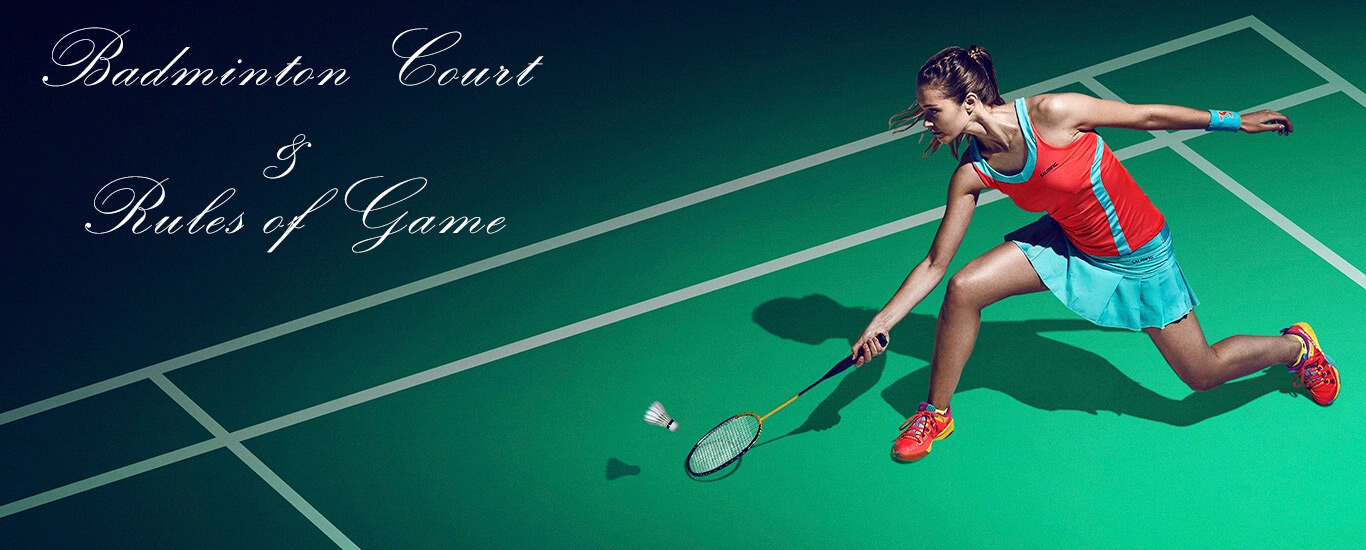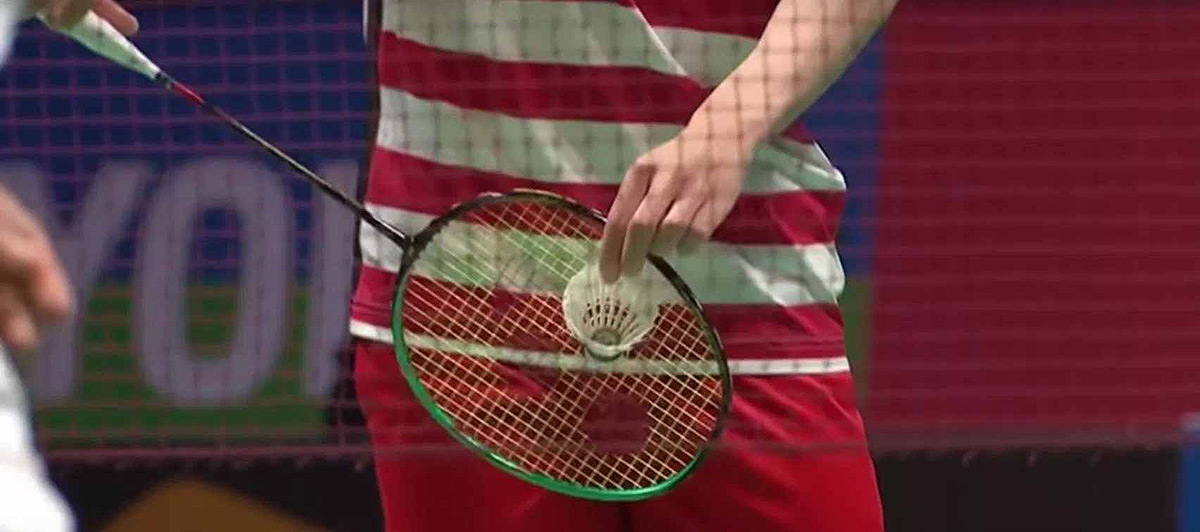
Basic Information about Badminton and Badminton Court
If badminton is nothing but an interesting activity to play in between barbecuing with your friends then we are sorry to inform you that you are missing out on a quite exciting fast racquet sport with a lot of breathtaking moments. If we`ve managed to intrigue you, yet you lack the needed Badminton related information and knowledge, we are here to help you. Read on to find out everything you need to know!Leaving aside the exciting badminton-alike activity in your backyard, professional badminton is played indoors on a rectangular court with special dimensions. Furthermore, this sport can be played as a “singles-one on one” game or as “doubles-four players included”.
The badminton court itself is divided into halves by a net and usually by the rules, it is marked simultaneously for both the singles and doubles play. The full width of the Badminton court is 20 ft. (6, 1 meter) but when a singles game is played this width is reduced to 17 ft. (5, 18 meters) while the length is always the same without the singles/doubles exception- 44 ft. (13, 4 meters). With a centerline, the badminton court is divided into left and right service courts, and both of them are marked by a center line named short service line at a 6 ft. 6 inches (1, 98 meters) from the net.
From this line is the serving done. When it comes to the doubles game, the badminton court has a shorter serve-length dimension by 0, 76 meters when compared to the singles game (the doubles service line or long service line).
A short history of How Badminton was invented
Although badminton is one of the Olympic's newest sports, you`d be surprised to find out its roots date way back (2,000 years ago) when ancient civilizations in Egypt, Greece, India, and China used to play the games named battledore and shuttlecock.
Historically, it all started back in the 1860s when British army officers started playing the so-called Indian Poona while being stationed in India. More than a decade later in 1873, the army officers returned to England, took the childish game with them, and literally turned into the now known Badminton sport.
Back in those days, the Poona “activity” was “presented” to a party organized by the Duke of Beaufort at one of his country estates called “Badminton”- hence the name of this sport.
Later on - in 1899 were held the first unofficial All-England championships for men and women (the next year). Decades after the formation of The Badminton World Federation in 1934, the first-ever official championships and tournaments were held not only in England but in several other countries as well such as Indonesia, Denmark, and Japan (in 1977).
After a few “test drives” as a demonstration and exhibition sport, finally in the year of 1992 Badminton became a full medal Olympic sport for both men and women; and for singles and doubles.

Types of Badminton Courts
As we previously mentioned, although this sport was born and played on the streets as a fun and recreational activity, over the decades turned into a professional sport and one of the most followed. Badminton is usually played on four different surfaces:
-
Synthetic surface PVC/PU
The most common surface used for top-notch Badminton venues is this synthetic surface and for a number of reasons. Usually laid upon a wooden base, these badminton courts are anti-slippery meaning fewer injuries, provide a good bounce, reduce the stress on your knees and ankles, and reduce the chances of injury. Furthermore, they offer an extraordinary grip that will allow you to jump and swiftly shift your direction.
-
Wooden Surface
Other than the synthetic surfaces, every now and then you will be able to see wooden courts as well. They are known for being shock absorptive but unfortunately, they are more slippery than the synthetic ones (less traction and struggles with proper grip). Furthermore, wood is known for having a fragile nature meaning higher costs for maintenance.
-
Acrylic surface
This type of surface is much similar to the synthetic surface made from PVC/PU. Although they look alike and offer a similar feel, the acrylic surface is not as good as the synthetic one in terms of shock absorption (they are tougher). On the other hand, the acrylic surface has exceptional strength and durability.
-
Cement surface
Lastly, we must mention this surface too even though it is used for playing recreational outdoor badminton. As the name says it, the surface is concrete therefore, it doesn`t provide proper support for the feet meaning there are far greater chances for injuries.
How to do Maintenance of the Court and which things damage the court?
Besides mentioning that proper non-marking shoes are worn to the Badminton venues in order to protect the wooden/synthetic surface, there are also a number of other equally important things as well when it comes to maintaining the polished look of the surface. Here are the ones that are the most valuable:
For synthetic floors
- Daily removal of sticky substances such as chewing gums, tapes, etc. with gentle scraping
- Cleaning the surface with a special microfiber mop specifically designed for such floors and a neutral cleaner at least 2-3 times per day (avoid the usage of acid, caustic, or ammonia-based cleaners)
- Instead of hand-mopping, you can use auto-scrubber but always make sure the battery is fully charged before usage (this will prevent battery acid leaks)
- In order to regain the shine and make it less slippery, you can scrub the floor with white vinegar or silicone thinner maintaining one scrub direction only.
- All of the chairs and additional movable equipment should have wheels and accordingly appropriate support that won`t indent or scratch the floor
For wooden floors (they are more delicate to handle and require more maintenance)
- Every two to three years power sanding should be performed which will bring back the fresh look and the coarseness needed for a good grip.
- Every now and then, the anti-skid coating should be applied in order to enhance the foot grip.
- Constant maintenance cleanups on a daily basis with specialized wooden floor cleaning liquid
- Replacement of damaged planks
- Applying fresh color around the net poles
- Repainting the lines to make them more visible
Badminton Net details and height/width
Badminton nets are always placed over the doubles sidelines and run the entire length of the court (6, 1 m). At the edges, the net height is 1.55 m high but as it comes to the center of the court it sags a bit resulting with 1.52 m height. The net itself is placed 0.76 meters above the floor and it has an equal 0.76 meters width which creates an equal 1:1 opening/net ratio. Commonly the net is made from vinyl, polyethylene, or nylon.How to find a Badminton court near me!
Probably the easiest way to find a badminton court would be by doing online research. This way you would be able to find not only the location but the needed additional information such as a webpage, contact number, and pricing. If you are looking for a more long-term solution, then searching for a serious and professional Badminton local club that will provide you with the needed knowledge and have all the experience is most certainly something to search for.
They will guide you through the process of learning Badminton, introduce you to all of the rules and regulations, and on top of this, help you enter the badminton community.
Or you can ask the Google Assistant "Badminton Court near me" and Google will show the results relevant and near to your location.

Basic Badminton Rules each player should know
Here are some basic badminton rules which are truly the foundation of this sport:
- Each and every game starts with a coin toss which allows the winning party to either choose between serving first or receiving the serve.
- In order to win the match you need to win 2 sets out of 3 with 21 points each (if the result is tie 20-20 the first player that scores 22 points-wins the set; this can go as high as 30 points-nothing more)
- The net should never come in contact with the badminton racket or the body
- You mustn’t play net shots when they are on the other side of the net (crossing over is strictly forbidden)
- Point is earned when the birdie lands out of bounds, hits the floor, or a fault is committed
- While being on your side, you can hit the shuttle only once and deliver it to your opponent`s side (if you fail at it – your opponent earns the point)
- During serving, the shuttlecock should always be hit from below the waist at an upward angle
- Until you release the shuttlecock (serve) you must n’t step on any of the lines on the court
- You must make sure you are standing inside the left or right serving court when serving and when receiving in the diagonally opposite box from the person serving (your opponent)
- Proper serving means the birdie shouldn’t touch the net and that it should cross the short serve line
What are the rules of singles?
At the beginning of the game when the score is 0-0, the server serves from the right service court. If the server`s score is odd (numbers which start at one and go up by two for example 1, 3, 5, etc.) the server serves from the left service court and vice versa, if the server`s score is even (numbers which start at zero and go up by two for example 0, 2, 4, 6, etc.), the server serves from the right service court. This is the main reason why the left service court is known as the odd service court and the right one as the even one. According to this, if you are a server and constantly winning, you will keep serving each point from a different side.In the meantime, the receiver`s position is pre-determined by the server`s score meaning he/she should stand in the diagonally opposite service court from the server. If the receiver wins a point, he/she becomes the new server and serves from the left or right serving court accordingly to the even/odd number score rule.
What are the rules of doubles?
Although most people are confused especially when it comes to serving patterns seen in doubles badminton games, we assure you - it is quite simple. Once the serving pair is chosen by the toss of a coin and the badminton game starts, the chosen person who will serve first follows the even/odd rule which is valid in the doubles game too. If the serving team wins a rally, the winning pair shifts their sides, and the same person continues to serve. While one person serves, accordingly the partner takes the other service court and the same idea applies to the receiving side as well.Once the serving is done, each and every person can move freely on the badminton court. It is important to remember that only the winning serving team swaps service courts while the other receiver team never changes their service courts. When the receivers win a rally, then and only then, the serve passes to them, they start serving from the position they are in according to the odd/even score rule (they don’t change their service courts). If they win-they change sides.
What are considered faults in the game?
Here is a shortlist of things that are considered faults while playing. The one who makes the fault loses the rally.
- In serving the shuttlecock shouldn’t be struck from above the server`s waist. You mustn’t use anything but an upward swing direction. And your racket head shouldn’t be pointing upwards when you hit the shuttle. All of these are considered Service faults.
- When a rally is in play you shouldn’t touch the badminton net nor should you touch the shuttle with your body or clothes. This is a contact fault.
- Double hits are forbidden
- When you are a receiver, you cannot move your feet away from where you are standing. If you do so, it is the receiver's fault. Once your opponent hits the shuttle, you can move.
- Over the net fault says that your racket shouldn’t invade your opponent`s side in order to hit the shuttle not until it crosses to your side of the net.
- The shuttlecock shouldn’t fall into the wrong receiving court (it should always be in the diagonally opposite court; serving from the left court should fall into the right one).
- The feet shouldn’t cross the boundaries (lines) of the serving or receiving court.
- Touching the net with body, racquet, or clothes is strictly forbidden.
- Invading the opponent`s court
Misconducts and Penalties
Badminton such as any other sport is regulated by Laws that are amended and adopted by the IBF (International Badminton Federation) and must be respected. According to the laws of Badminton, players are not allowed to interfere with the continuous play of the match (cause delays in order to gain back strength), are not allowed to leave the court (except for the allowed intervals), deliberately cause delay or suspension of play, deliberately modify/damage the shuttle in order to change its speed, behave in an inappropriate or offensive manner. If anything of the above-mentioned misconduct happens, the umpire is allowed to issue a warning, fault the offending side, or even disqualify the offending side from the match.
An example of unusual misconduct happened back in 2012 at the Olympic Games held in London when four pairs of players (one from China, one from Indonesia, and two from South Korea) deliberately tried to lose their matches in order to have an easier draw in the knockout stages.
Conclusion
Exciting and fast! Unpredictable and physically demanding!
We guarantee you, trying to play Badminton not only in your backyard but also on a professional synthetic surface will become your favorite physical activity. It will challenge you in ways beyond your imagination. Buy a proper pair of badminton shoes, find and book the nearest Badminton venue, invite your friends, and be prepared for an extraordinary physical activity in this best racquet sports.
Read About - Top 7 Common Badminton Injuries and Prevention
Your email address cannot be published. Required fields are marked*

 My Account
My Account Track Order
Track Order Sports Guide
Sports Guide
No comments